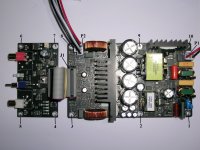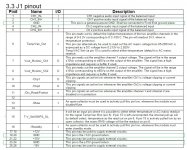I'm going to use this enclosure (no affiliation)
https://www.ebay.com/itm/122109781051
It will require some work, but I kind of like it, very industrial. 😉
https://www.ebay.com/itm/122109781051
It will require some work, but I kind of like it, very industrial. 😉
A few observations relating to grounding after probing around the FFA001-V3 module. They are in agreement with stryx posting https://www.diyaudio.com/community/threads/2x150w-amp-module-for-sale.388868/post-7212954
Please see attachment 1 and 2
Main board:
There is no direct (DC) connection between any of the mounting holes.
Hole #9 is directly connected to the PCB ground. Thus there is also 0 Ohm between this hole and:
Negative speaker cables (P2 connector pins 2, 4)
J1 connector pins 3, 19, 20, 23, 24
Hole #1 is capacitively connected to Live and Neutral AC mains input (P1 connector, pins 1, 3) through 1nF capacitors. It serves as the grounding connection for the mains LP input filter.
There is a 300pF capacitance measured between this hole and PCB ground (Hole #9). I don’t know if it is due to a real capacitor (component) or it is parasitic.
Holes #2, 3, 8, 10 DC float. Holes #2, 3, 8 measure 860pF to Hole #9 (smd capacitors on each) and 220pF to Hole #1. Hole #10 measures 0pF to both Hole #9 and Hole #1
RCA input buffer board:
Buffer board is connected to the main board through the ribbon cable. It’s ground plane is an extension (0 Ohm) of the main board general ground.
Holes #4, 7 DC float. They measure 0pF to ground.
Holes #5, 6 are shorted together. Each is connected to ground through an 820 Ohm resistor in parallel to a small capacitor, thus they measure 410 Ohm to ground.
Input RCA barrel is each connected to ground through a 0 Ohm smd resistor
George
Please see attachment 1 and 2
Main board:
There is no direct (DC) connection between any of the mounting holes.
Hole #9 is directly connected to the PCB ground. Thus there is also 0 Ohm between this hole and:
Negative speaker cables (P2 connector pins 2, 4)
J1 connector pins 3, 19, 20, 23, 24
Hole #1 is capacitively connected to Live and Neutral AC mains input (P1 connector, pins 1, 3) through 1nF capacitors. It serves as the grounding connection for the mains LP input filter.
There is a 300pF capacitance measured between this hole and PCB ground (Hole #9). I don’t know if it is due to a real capacitor (component) or it is parasitic.
Holes #2, 3, 8, 10 DC float. Holes #2, 3, 8 measure 860pF to Hole #9 (smd capacitors on each) and 220pF to Hole #1. Hole #10 measures 0pF to both Hole #9 and Hole #1
RCA input buffer board:
Buffer board is connected to the main board through the ribbon cable. It’s ground plane is an extension (0 Ohm) of the main board general ground.
Holes #4, 7 DC float. They measure 0pF to ground.
Holes #5, 6 are shorted together. Each is connected to ground through an 820 Ohm resistor in parallel to a small capacitor, thus they measure 410 Ohm to ground.
Input RCA barrel is each connected to ground through a 0 Ohm smd resistor
George
Attachments
It's a real capacitor between smps secondary and primary ground areas, you can find that big smd capacitor near hole #9.There is a 300pF capacitance measured between this hole and PCB ground (Hole #9). I don’t know if it is due to a real capacitor (component) or it is parasitic.
Erica.C it's done everything possible to prevent ground loop.
Thanks stryx.
I agree that Eric has done a good job.
That C53 big black cap measures as 2.2nF (Y1222)
George
I agree that Eric has done a good job.
That C53 big black cap measures as 2.2nF (Y1222)
George
Hi, Mga2009Hi Erica,
Do you have any developments on the 2 channel amp + DSP?
Cheers and good luck
Currently, there is no such development plan, but now a friend invites me to develop a personal network player, which is similar to combining this power amplifier module with the Raspberry Pi, adding a big size touch screen and making a streaming media player. We are preparing to do prototypes after the new year.
Thanks,Eric
Good luck with that project!Hi, Mga2009
Currently, there is no such development plan, but now a friend invites me to develop a personal network player, which is similar to combining this power amplifier module with the Raspberry Pi, adding a big size touch screen and making a streaming media player. We are preparing to do prototypes after the new year.
Thanks,Eric
To bad there is no plan for the development of DSP + AMP. Here in the DIY scene are eager for a good (and powerful) plate amp with 2 (or 3) channels + DSP to make our active speaker dreams come true!
Could not agree moreGood luck with that project!
To bad there is no plan for the development of DSP + AMP. Here in the DIY scene are eager for a good (and powerful) plate amp with 2 (or 3) channels + DSP to make our active speaker dreams come true!
Honest question, I've seen several options for plate amps + dsp (minidsp, daytonaudio, getshow, hypex, etc)... what's wrong with them?To bad there is no plan for the development of DSP + AMP. Here in the DIY scene are eager for a good (and powerful) plate amp with 2 (or 3) channels + DSP to make our active speaker dreams come true!
A steaming integrated with multiple inputs and subwoofer outputs would be good. The Yamaha WXA-50DS doesn't have much competition. There's space in that market. WIIM plus this module can do the job well.Hi, Mga2009
Currently, there is no such development plan, but now a friend invites me to develop a personal network player, which is similar to combining this power amplifier module with the Raspberry Pi, adding a big size touch screen and making a streaming media player. We are preparing to do prototypes after the new year.
Thanks,Eric
Honest question, I've seen several options for plate amps + dsp (minidsp, daytonaudio, getshow, hypex, etc)... what's wrong with them?
-. HypeX --> top of the line, but expensive @ over USD$350 ea.
-. MiniDSP --> Hard to find and almost as expensive as HypeX
-. AFAIK Dayton does not have a full range plate amp with DSP with a decent Class D amp attached.
-. IDK that Getshow is, but after a google search it looks like a chinese/karaoke plate amp provider... I am kind of looking for something a little bit bette, maybe not SOTA, but good... with a GOOD ADC and a GOOD DAC.
mmmm I see.I am kind of looking for something a little bit bette, maybe not SOTA, but good... with a GOOD ADC and a GOOD DAC.
Do you have any feedback on the Getshow plate amps?¿mmmm I see.
I also noticed Sanway plate amps, which seem god enough, bu the DSP, ADC and DAC sections are unknown...
maybe you guys can start a new plate amp thread and leave this space for Erica info. Thanks.
I don't.. what I will do a some point is to order some FFA001 HB version with a front end from minidsp, that would be fun.Do you have any feedback on the Getshow plate amps?¿
Hello Eric
What modules do you have available now? Are there any of the larger ones ready?
Thanks and regards
Randy
What modules do you have available now? Are there any of the larger ones ready?
Thanks and regards
Randy
Hi, RandyHello Eric
What modules do you have available now? Are there any of the larger ones ready?
Thanks and regards
Randy
I would recommend the higher output power FFA002V1 for you, it's the same I/O interface as FFA001V3. It's a limited quantity this time, and just for the 170-264Vac input country which will be suitable for you.
Thanks,Eric
... On amp and smps pcb near main rectifier and three blue capacitors it is connection for EMI filter ground, you need to use that connection for optimal EMI filtration.
Today I listen that small amplifier, for his price its sound really good. I don't have any noise oe hum. I used just ground connection just EMI filter so it was impossible to have an ground loop. ...
I put amplifier in some aluminium box and grounded all mounting holes and.... noise, no hum, no nothing, just deep silent.
...
Main board:
There is no direct (DC) connection between any of the mounting holes.
Hole #9 is directly connected to the PCB ground. ...
Hole #1 is capacitively connected to Live and Neutral AC mains input (P1 connector, pins 1, 3) through 1nF capacitors. It serves as the grounding connection for the mains LP input filter.
...
RCA input buffer board:
Buffer board is connected to the main board through the ribbon cable. It’s ground plane is an extension (0 Ohm) of the main board general ground.
...
Input RCA barrel is each connected to ground through a 0 Ohm smd resistor
...
So, for a novice, if I were to use one of these, would I ground
- Only the EMI filter ground (or #1 on gpapag's diagram)
- All mounting holes
- Some other arrangement that is apparent to someone more experienced?
I would be using this as a stereo amp, would I want the regular (not "High Bass") version?
I am not in a real hurry, so I could wait for the higer power version if it is not a lot more expensive - Has the price difference been mentioned and I missed it?
Here are some summary details of my build in case it's helpful reference for others:
- Chassis is a Galaxy 2U 330x230, with full vented top and bottom from the diyAudio Store
- Modushop cut the IEC opening and screw holes as part of my order
- Three FFA001 modules plus the XLR I/O boards from the beginning of this thread are in the chassis
- There is JUST enough room or all this laid out flat in the chassis I have (though the I/O boards are mounted above the amp modules so that there is room for XLRs above and speaker binding posts below
- Mains inlet is a Schurter 4304.6090
- Mains earth ground is connected to the chassis (with anodizing sanded away)
- Mains AC is connected in parallel to the three modules
- XLR input openings/mounting hole screws and speaker binding post holes are hand drilled
- Fan(s) were tried but not successfully implemented due to spacing and noise issues
- Eric has addressed the noise and voltage issues with fan circuit in the updated I/O boards, which I have not tried (https://www.diyaudio.com/community/threads/2x150w-amp-module-for-sale.388868/post-7181561)
- Three modules in my chassis get warm under normal use, but not worryingly so (I have no concerns about the heat in my build)
- XLR-to RCA adapters work fine for me (https://www.amazon.com/gp/product/B07RQNGDF2/)
- The build performed very well in my main stereo rig and sounds very good
- I tested the build with a MiniDSP Flex Eight for multi-channel experimentation and it worked well
Hi @von Ah, that looks really good. I'm sort of new to this but it looks like loads of fun. Are there any clear documented instructions that one could follow to put a multi-channel amp together. I'm not an electronics engineer but would be comfortable following step by sep instructions.
By the way, I'm sure you tested the amp in your home theatre setup, how did it sound?
Also, I noticed the module offers 2 x 150W at 8 ohms, what is the rating at 4 ohms? Can the 2 channels be bridged?
Is there a more powerful module available?
- Home
- Vendor's Bazaar
- 2x150W Amp module for sale

